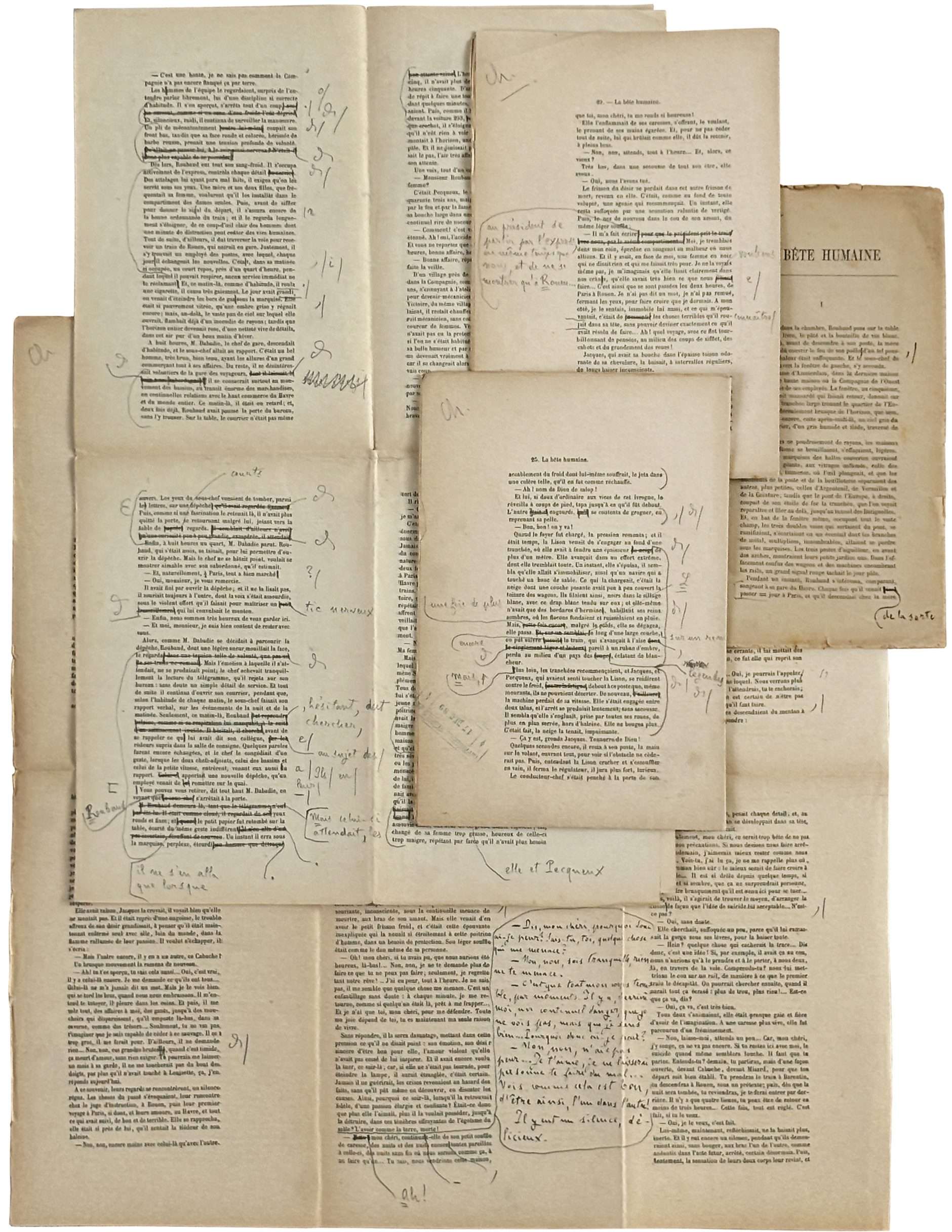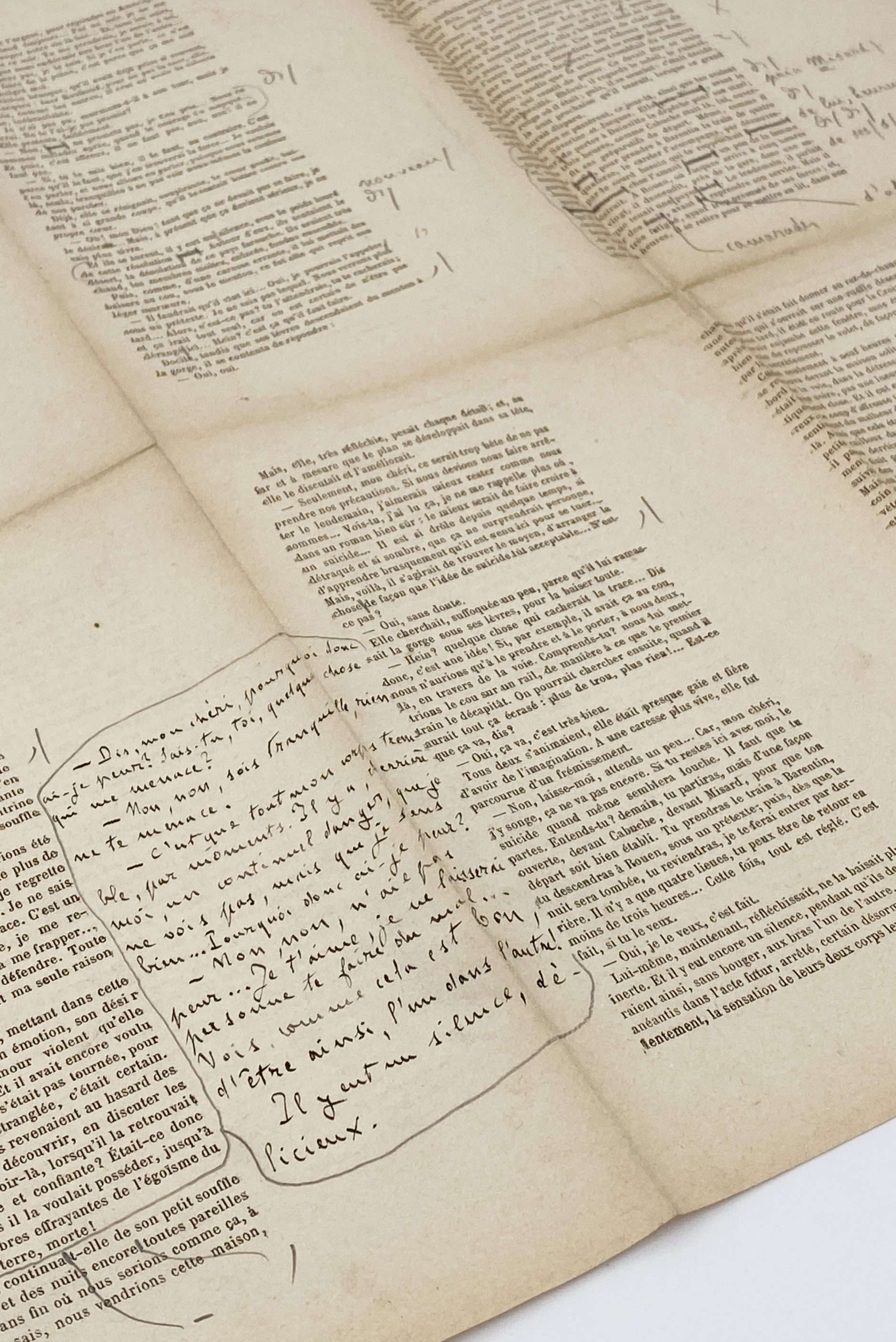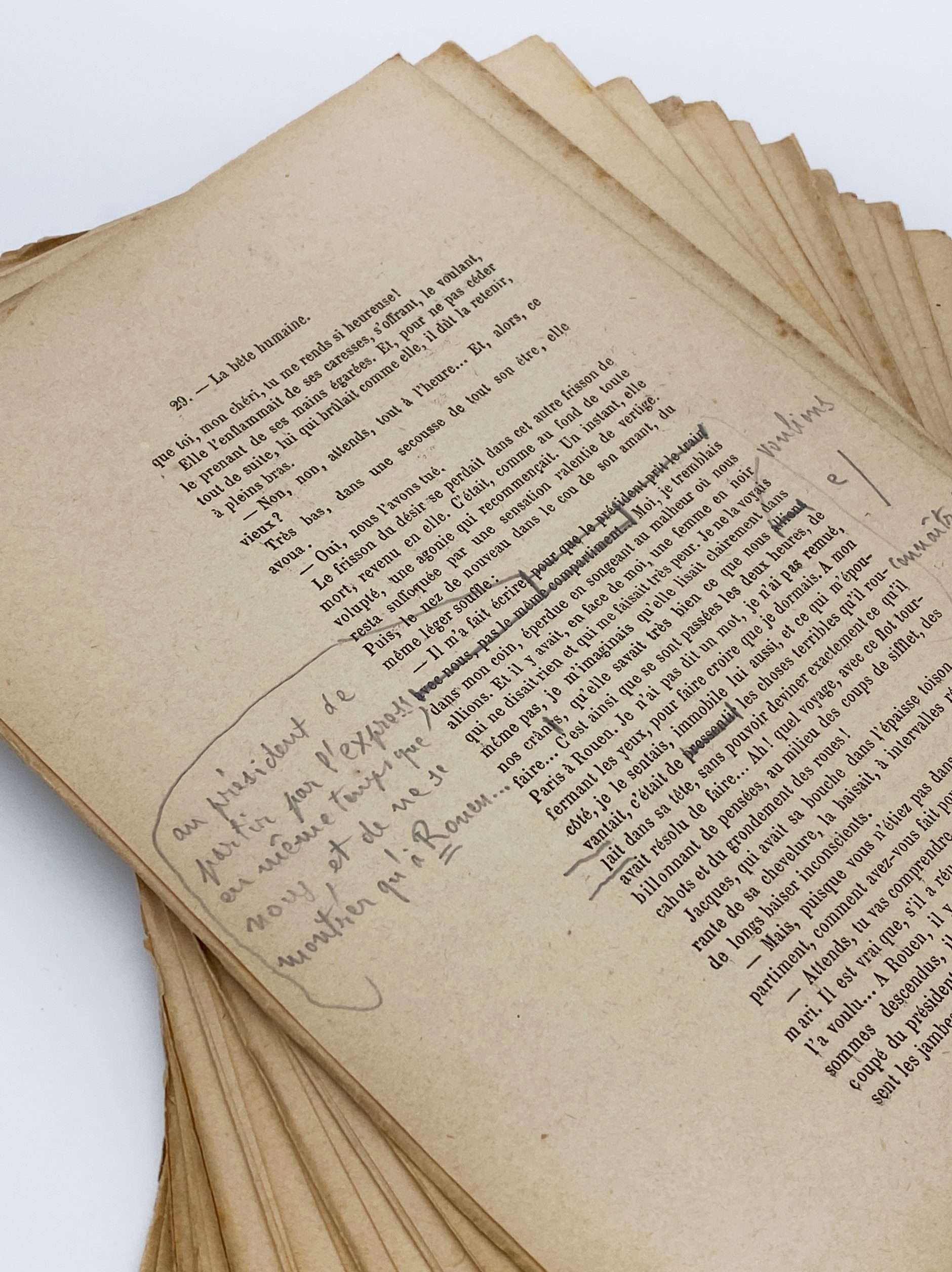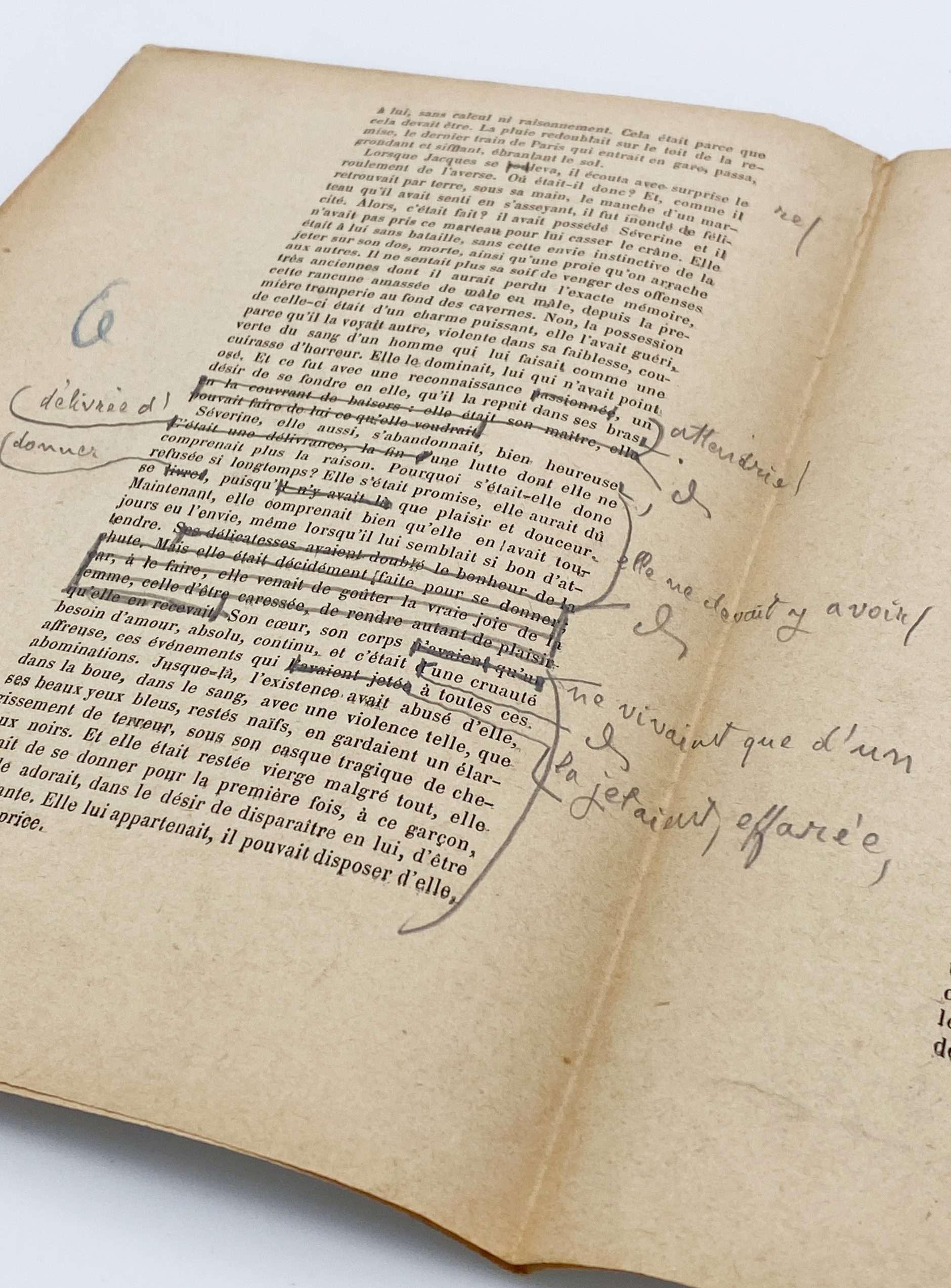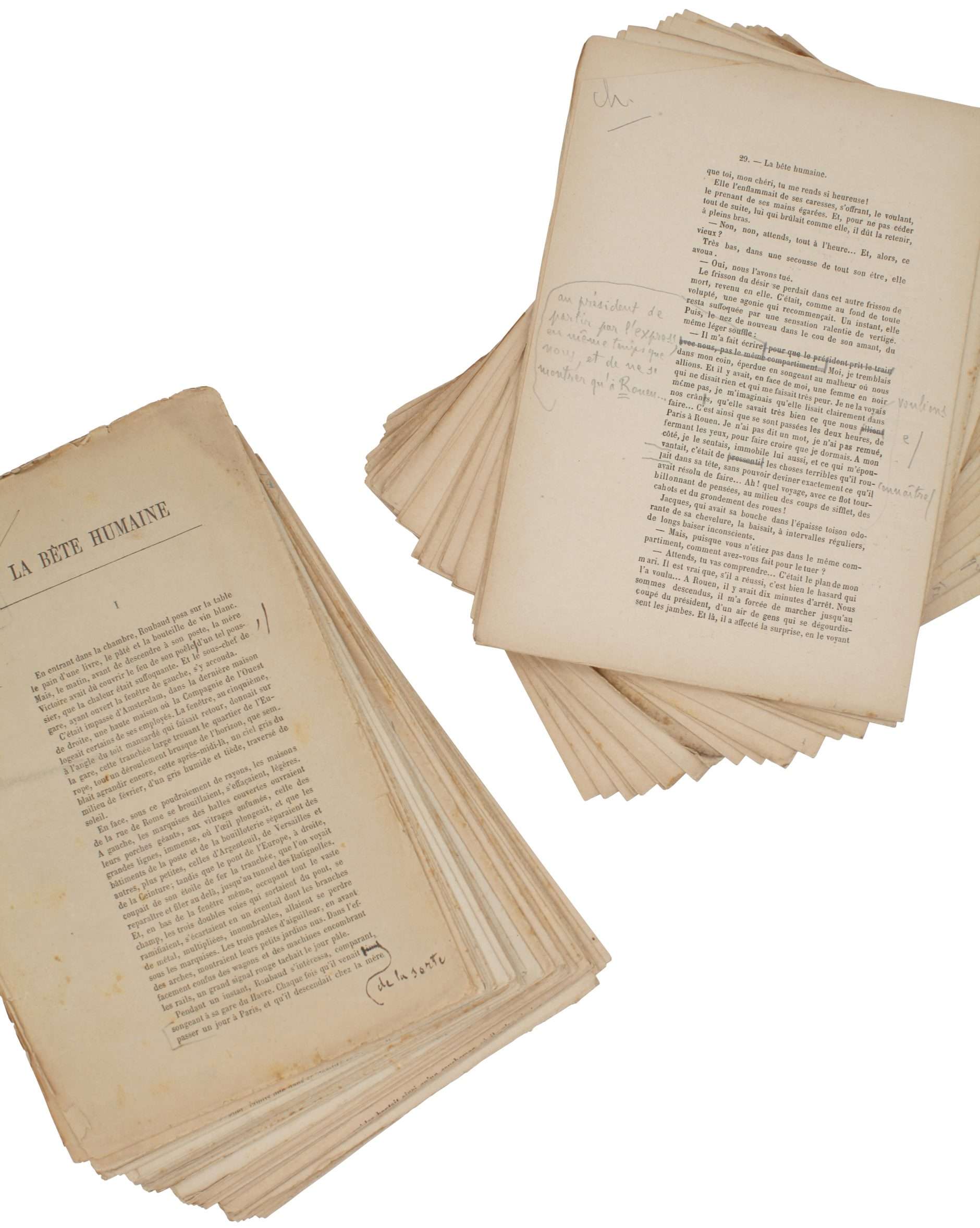ZOLA, Emile (1840-1902)
Corrected proofs for his novel The Beast within
Paris, January 1890, 45 proofs printed on recto
« I love you, I will never let anyone hurt you… See, how good it is to be so, one in another ! »
Fact sheet
ZOLA, Emile (1840-1902)
Corrected proofs for his novel The Beast within
Paris, January 1890, 45 proofs printed on recto
Very good overall condition except some slightly frayed margin on the first folios, some browning
A precious complete set of proofs for the original edition of his masterpiece La Bête humaine, the seventeenth volume in the Les Rougon-Macquart series.
At the heart of the writer’s creative process: a total of 45 proof sheets with extensive autograph corrections in Zola’s own hand.
One of the very rare Zolian relics still in private hands
La Bête humaine in the Making
The proof sheets in this set bear witness to the author’s progress in writing his masterpiece. Émile Zola undertook a meticulous rereading of every line, refining the style, striking through passages, and making corrections to achieve greater accuracy in tone and rhythm. As such, the set is extensively annotated, with the exception of proof sheets no. 35 to 38. The most substantial corrections appear on sheets no. 2 to 13 and no. 40, which correspond to Chapters I to IV and XI. Special attention was also paid to typography, further evidence of the naturalist writer’s thorough and exacting rereading.
Georges Charpentier added penciled notes on twenty-nine of the proof sheets, along with two annotations instructing Zola to henceforth adhere to the paginated layout.
These proofs represent an intermediate stage between the manuscript and the published text, as evidenced by certain excerpts:
– « Roubaud, près de sa femme écoutait, en fixant également sur elle des yeux vacillants. Il y eut une minute de mortelle angoisse » become « Près de sa femme, Roubaud écoutait, en fixant également sur elle ses gros yeux pâles » then, in the final version, « Près de sa femme, Roubaud écoutait, en fixant sur elle ses gros yeux vifs ».
– « Seulement, ce matin-là, Roubaud dut reprendre haleine, comme si sa respiration lui manquait, à la suite d’un saisissement inutile. Il hésitait, il chercha avant de se rappeler ce que lui avait dit son collègue » become « Seulement, ce matin-là, Roubaud, hésitant, dut chercher, avant de se rappeler ce que lui avait dit son collègue ».
Folio #40 includes an important addition of seventeen lines, in which the author plays with the lyrical register. Love and death invite each other:
« – Dis, mon chéri, pourquoi donc ai-je peur ? Sais-tu, toi, quelque chose qui me menace ?
– Non, non, sois tranquille, rien ne te menace.
– C’est que tout mon corps tremble, par moments. Il y a, derrière moi, un continuel danger, que je ne vois pas, mais que je sens bien… Pourquoi donc ai-je peur ?
– Non, non, n’aie pas peur… Je t’aime, je ne laisserai jamais personne te faire du mal… Vois, comme cela est bon d’être ainsi, l’un dans l’autre !
Il y eut un silence délicieux. »
The novel
La Bête humaine, the seventeenth volume in the Rougon-Macquart saga, was written between May 1889 and January 1890, and released in bookstores by Georges Charpentier during the first week of March 1890, following its serialization in the weekly magazine La Vie populaire from November 14, 1889, to March 2, 1890. Like Germinal (1885), it focuses on a facet of the industrial and working-class world of the late 19th century.
In this judicial novel, the main characters are murderers. Émile Zola wove together several real-life criminal cases, likely including the infamous crimes of “Jack the Ripper,” creating a bleak, violent, and monstrous tableau in which killings occur for motives as varied as greed, jealousy, or even hereditary madness. Through this narrative—and his exploration of remorse—Zola situates his work within contemporary debates on the moral and social meaning of crime. His writing was nourished by readings of Crime and Punishment by Dostoevsky (in a French translation published in 1885) and criminological studies by Cesare Lombroso, Prosper Lucas, and Gabriel Tarde.
He also takes the opportunity to satirize a judiciary subservient to political power through the character of Judge Denizet. The judicial error he commits underscores the limits of justice as administered by men and the inherent fallibility of any rational method.
Readers were struck by the confrontation between tradition and modernity, by the stunning fusion of primal instinct and technological advancement. The locomotive is endowed with human traits, becoming a character in its own right—ultimately transformed into a tragic “blind and deaf beast loosed amid death.”
Finally, this lyrical element is enriched by a fantastical dimension, as Henri Mitterrand explains: « La Bête humaine endures through its fantastical elements, the intensity of its leitmotifs and rhythms, and the perfection of certain passages—such as the final ones—where the extravagance of the action and the baroque modernity of the setting come together in astonishing harmony. »
Literary relics of Émile Zola are extremely rare in private hands. In accordance with the novelist’s wishes, his wife Alexandrine Zola entrusted nearly all of his manuscript materials to the nation in 1904. As a result, the invaluable dossiers and a large portion of the corrected proofs for Les Rougon-Macquart and Les Trois Villes are now held by the Bibliothèque nationale de France (BnF).
This set of proofs was unknown to Henri Mitterand when he prepared his edition of La Bête humaine for the Bibliothèque de la Pléiade (Paris, Gallimard, NRF, 1966; reissued in 2021).
